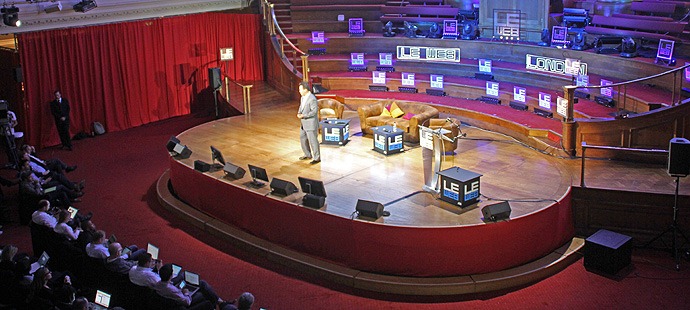Presenting at LeWeb London, Analyst Jeremiah Owyang of Altimer explained that the conference theme (“Faster Than Real Time”) referred to the importance of anticipating customer needs, not just reacting to them as fast as possible.
He used the retailer Target as an example: the company uses predictive technology to give special offers for products that customers are likely to want in the future, and in one infamous case knew that a teenage girl was pregnant, even before her father was aware of it.
Just as the top sport stars have learned to anticipate where the ball is going to be, based on their long experience of the underlying patterns of play, organizations can now monitor the patterns of business and take action.
The challenge in business is that there is rarely just one ball in play. Owyang outlined the complexity of the problem, multiplying the number of sources of information by the number of different possible channels, the number of different screens, and the different stages of engagement. This results in a massive 525 potential ways that customers can interact with a company, even without taking into account different customer profiles and geographic location.

Owyang talked about his company’s research into the “Dynamic Customer Journey,” where today’s consumers face an overwhelming amount of choices:
“A few weeks ago, I was in Times Square. I had a mission to count every logo from a fixed position. I tried to do it. But in a few seconds, I gave up. There were so many digital screens that were constantly changing – at least 15 of them. This is what we call the dynamic customer journey. This same experience will be in the living room and the retail store in the future”
And the amount of data available is rising exponentially:
“250 million photos are uploaded to Facebook each day. If you printed them out, would be 80 Eiffel Towers of photos each day.”
He gave two examples of organizations that are using new technology to change the way they interact with customers. The first was the famous case of Tesco using the walls of the Seoul metro to create a “virtual supermarket” where shoppers could use their mobile devices to choose products and have them delivered.

Photo: DesignBoom.com
The second was American Eagle’s digital signage in Times Square, where customers could have their “15 seconds of fame” by having their picture taken in the store, which was then displayed on a massive billboard.

Photo: michaeltk
Organizations are struggling to figure out what new sources of information they need to track and how the experience will change across different channels and devices. And in the future, with technology that can provide highly contextual information to customers, advertising itself may evolve to something else, resulting in disruption to traditional revenue streams.
Owyang also talked about Altimeter’s research into “The Sentient World”, where everything around is “alive and full of information.”
Examples included GE Lighting’s iphone application that lets homeowners view the effects of different lighting choices on the mood of their own rooms.
He also talked about how new technology is helping monitor our own bodies, whether it’s running devices that track our performance, or “smart pajamas” for babies (tagline: “we know how your baby feels”). And how customer experiences are being changed, in restaurants featuring “e-tables” that react to the food that is placed on them, or by looking at the world through devices such as Google Glass
Owyang ended with three big questions that business need to answer in the future:
- If everything emits data, how will we sort intelligence from noise?
- How will consumers communicate with inanimate objects? How will these interactions be measured?
- At what point does this new world become self-sufficient beyond human intervention? Which companies will benefit from this?
For more about Altimeter’s main research themes, you can visit their site, that gives more details about their research into the Dynamic Customer Journey, the Adaptive Organization, and the Sentient World.


Comments
7 responses to “The Future of Business: Faster Than Real-Time?”
[…] point in time. But let’s hope that all the C-suite hype around Big Data and the notion of‘faster than real time’ will provide the motivation to learn more about this all important branch of […]
[…] at this point in time. But let’s hope that all the hype around Big Data and the notion of ‘faster then real time’ will provide the motivation to learn new leadership […]
[…] on timoelliott.com Share this:TwitterFacebookJ'aime ceci:J'aimeBe the first to like this. Catégorie : […]
[…] on timoelliott.com Publié dans Non […]
[…] Drew B blogged about the keynote, as well as Timo Elliott of SAP and on the SAP blog. Filed Under: Research Themes, […]
[…] Drew B blogged about the keynote, as well as Timo Elliott of SAP. var dd_offset_from_content = 80; var dd_top_offset_from_content = 0; Filed under: Speech, […]
Great post, Timo. One of your best. Thanks for sharing.